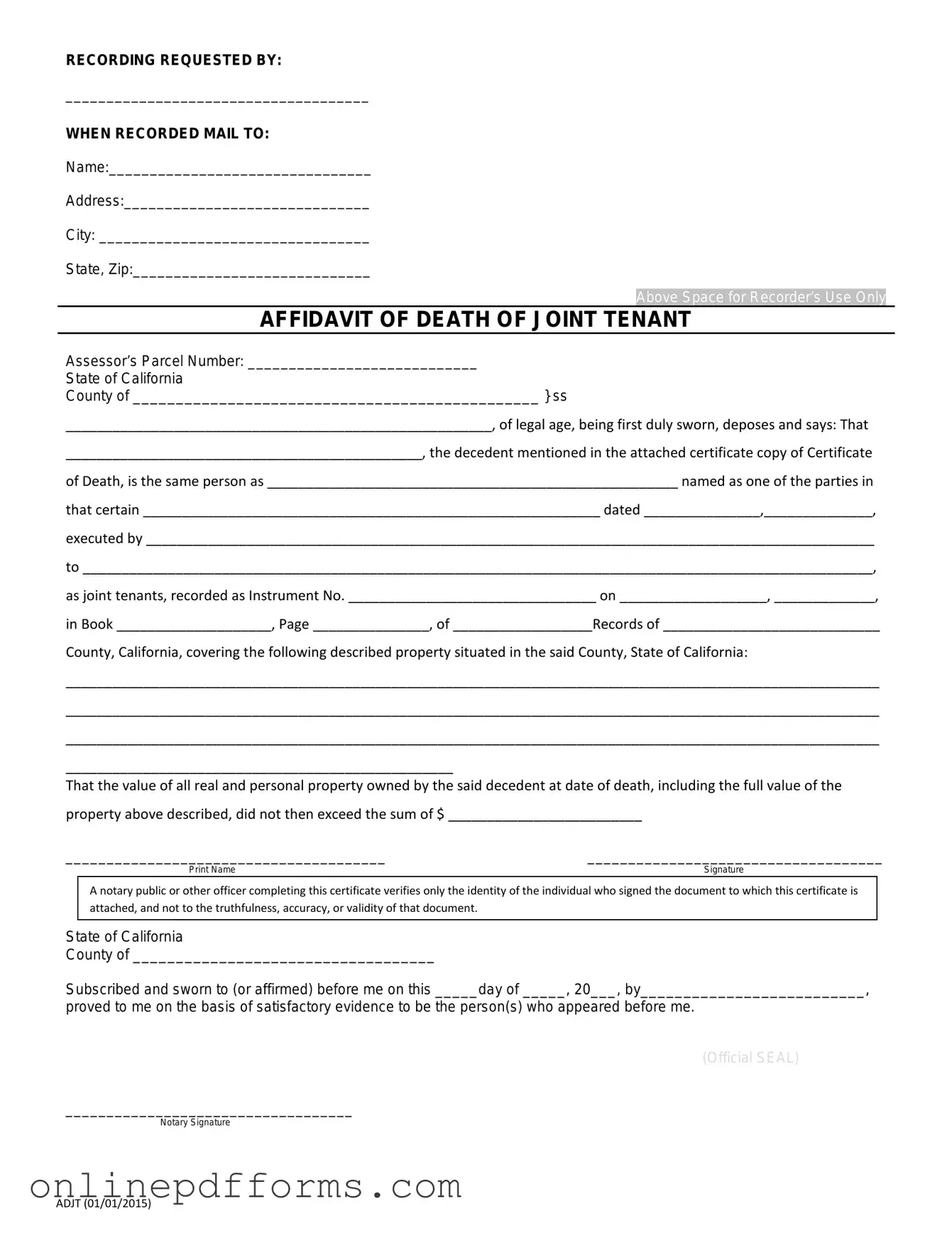The California Death of a Joint Tenant Affidavit form serves a specific purpose in real estate transactions, particularly when one co-owner passes away. This document is similar to the Affidavit of Death form, which is utilized to establish the death of an individual for various legal purposes. Both documents aim to provide a clear declaration of death, but the Affidavit of Death may not necessarily relate to joint tenancy. Instead, it can be used in different contexts, such as settling estates or transferring property ownership, thereby ensuring that the deceased's affairs are handled appropriately.
Another related document is the Transfer on Death Deed (TODD). This deed allows an individual to designate beneficiaries who will automatically inherit property upon their death. While the California Death of a Joint Tenant Affidavit focuses on the surviving tenant's rights and responsibilities, the TODD emphasizes the transfer of property outside of probate. Both documents facilitate the transfer of property ownership but do so in different legal frameworks and contexts.
The Living Trust Declaration also shares similarities with the California Death of a Joint Tenant Affidavit. A living trust allows individuals to place their assets in a trust during their lifetime, which can then be distributed to beneficiaries upon their death. While the affidavit is used after the death of a joint tenant to clarify property ownership, a living trust is proactive, designed to avoid probate and streamline the transfer of assets. Both documents reflect an intention to manage property effectively, albeit at different stages of ownership.
The Will is another important document that bears resemblance to the California Death of a Joint Tenant Affidavit. A will outlines how a person wishes their assets to be distributed after their death. In cases where property is held in joint tenancy, the death of one tenant may trigger specific provisions in a will. While the affidavit provides a mechanism for acknowledging the death of a joint tenant, a will serves as a broader directive for asset distribution. Both documents play crucial roles in estate planning, but they operate within different legal parameters.
The Probate Petition is also comparable to the California Death of a Joint Tenant Affidavit. This legal document is filed in court to initiate the probate process, which involves validating a deceased person's will and overseeing the distribution of their estate. While the affidavit is a straightforward declaration of death for joint tenancy purposes, the probate petition can encompass a wider range of issues, including debts, taxes, and disputes among heirs. Both documents are integral to the process of settling an estate, yet they serve distinct functions within that process.
The Certificate of Death is another document that shares a connection with the California Death of a Joint Tenant Affidavit. This official record, issued by a government authority, confirms the death of an individual and is often required for various legal and administrative purposes. While the affidavit is specific to joint tenancy and property transfer, the certificate provides the foundational proof of death necessary for many legal actions, including the use of the affidavit itself. Both documents ultimately serve to establish the fact of death, albeit in different contexts.
For those venturing into the world of all-terrain vehicles, understanding the necessary paperwork is vital. This includes knowing about the 4 Wheeler Bill of Sale, which serves as a critical document to formalize the transfer of ownership between parties. Completing this form not only establishes proof of sale but also ensures that both buyers and sellers are protected throughout the transaction process.
The Affidavit of Heirship is also similar in function to the California Death of a Joint Tenant Affidavit. This document is used to declare the heirs of a deceased person, particularly when there is no will. It helps clarify the distribution of property and assets among surviving family members. While the California affidavit focuses on the joint tenancy aspect of property ownership, the Affidavit of Heirship addresses the broader issue of inheritance rights, providing a means for heirs to claim their share of an estate without formal probate proceedings.
Lastly, the Notice of Death is comparable to the California Death of a Joint Tenant Affidavit in that it serves to inform interested parties about an individual's passing. This document is often used in various contexts, including real estate, to notify relevant stakeholders of the death. While the notice may not have the same legal weight as the affidavit, it plays a critical role in ensuring that all parties are aware of the changes in ownership or management that result from the death of a joint tenant. Both documents facilitate communication and transparency in the aftermath of a death, although they serve different purposes in the legal landscape.
